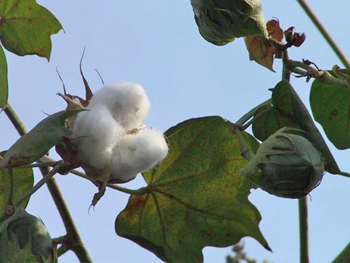Contents:
Common Names | Parts Usually Used | Plant(s) & Culture | Where Found | Medicinal Properties | Biochemical Information
Legends, Myths and Stories | Uses | Formulas or Dosages | Nutrient Content | How Sold | Warning | Bibliography
Scientific Names

- Gossypium herbaceum L.
- Malvaceae
- Mallow family
Common Names
- Cotton plant
- Ts’ao-mien (Chinese name)
Parts Usually Used
Inner bark of the root, seeds
Back to Top

Description of Plant(s) and Culture
Cotton is a biennial or triennial shrub that grows to about 5 feet high with woody roots and branches. The round, hairy, branching stems grow from a spindle-shaped root and bears hoary, palmate leaves with 5 pointed lobes. The flowers have 5 yellow petals, each with a purple spot near the bottom. The flower opens only for pollination; it withers after one day. The boll grows to golf ball size with a pointed tip, then the boll cracks and splits from the tip showing locks, or 8-10 seeds with fibers attached. The fruit is a 3 or 5 celled capsule, each cell containing a seed buried in cotton fiber. The open dried boll which holds the fluffed-out cotton is called the burr.
Back to Top
Where Found
Native to Asia, cultivated in many parts of the world. In the United States, the southern portion of the country is more successful in growing cotton.
Back to Top
Medicinal Properties
Abortifacient, aphrodisiac, emmenagogue, parturient, oxytocic
Seeds: mucilaginous
Back to Top
Biochemical Information
Resinous substance, phenolcarbonic acid, salicylic acid, betaine, sugar, essential oil
Back to Top
Legends, Myths and Stories
Economically, cotton is one of the most valuable plants. Cotton seeds and cotton seed meal are used for livestock feed and for making and scenting soap.
Needless to say, cloth has been made from this plant since ancient times.
Introduction of the cotton plant into China during the XI century, either by foreigners trading with the Chinese, or by Mongol conquerors of China. Cottonseed oil was formerly used in villages as food and for lamps. Its taste is very unpleasant, which fact is due to the Chinese roasting the seeds before expressing the oil. They used the cotton plant medicinally to treat leprous, scabrous, and other forms of skin diseases.
Back to Top
Uses
Tincture of the fresh inner root bark is used to treat amenorrhea, dysmenorrhea. Used to treat abscess of the labia, causes abortion, sterility, impotence, frigidity, tumors. The seeds are used to treat malaria and to increase nursing mother’s milk. The oil from the seeds has been studied as a male contraceptive. It was observed by the Chinese that there was a noticeable decrease in births in areas where cottonseed oil was used in cooking. The plant is used to check menstrual bleeding in the case of fibroids. The root is used to stop bleeding, especially internally. Leaves crushed to make an extract is used for diarrhea, dysentery, piles, gravel. Externally, used for rheumatism, a dressing for freckles, herpes, scabies, neuralgia, chronic headache, ulcers, sores, swellings, and wounds. Once used as a substitute for Ergot to promote menses. Used for parturient in childbirth: add 1/4 lb of the bark to 1-1/2 quarts of water; reduce to 1 pint by boiling. Take a wineglassful every 1/2 hour. Seeds used as a soothing cough remedy.
Back to Top
Formulas or Dosages
Infusion: boil 4 oz. of the inner bark of the root in a quart of water, reduce to a pint by boiling. The dose is 1/2 cup every 30 minutes.
Tincture: 1/2 to 1 tsp. in water.
Back to Top
Nutrient Content
Cotton seeds contain protein, vitamin E, fats
Back to Top
How Sold
Cottonseed oil and meal
Back to Top
Warning
Avoid during pregnancy since it is a uterine stimulant. May want to take it during labor and delivery.
Do not use without medical supervision.
Back to Top
Bibliography
![]() American Folk Medicine
American Folk Medicine, by Clarence Meyer, Meyerbooks, publisher, PO Box 427, Glenwood, Illinois 60425, 1973
![]() Chinese Medicinal Herbs
Chinese Medicinal Herbs, compiled by Shih-Chen Li, Georgetown Press, San Francisco, California, 1973.
![]() The Herb Book
The Herb Book, by John Lust, Bantam Books, 666 Fifth Avenue, New York, NY. copyright 1974.
![]() Indian Herbalogy of North America
Indian Herbalogy of North America, by Alma R. Hutchens, Shambala Publications, Inc., Horticultural Hall, 300 Massachusetts Avenue, Boston, Massachusetts 02115, 1973
![]() Planetary Herbology
Planetary Herbology, by Michael Tierra, C.A., N.D., O.M.D., Lotus Press, PO Box 325, Twin Lakes. WI 53181., Copyright 1988, published 1992
![]() The Yoga of Herbs: An Ayurvedic Guide to Herbal Medicine
The Yoga of Herbs: An Ayurvedic Guide to Herbal Medicine, by Dr. David Frawley & Dr. Vasant Lad, Lotus Press, Twin Lakes, Wisconsin, Second edition, 1988.
![]() Webster’s New World Dictionary
Webster’s New World Dictionary, Third College Edition, Victoria Neufeldt, Editor in Chief, New World Dictionaries: A Division of Simon & Schuster, Inc., 15 Columbus Circle, New York, NY 10023
